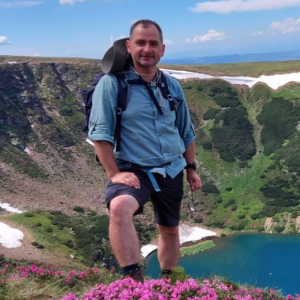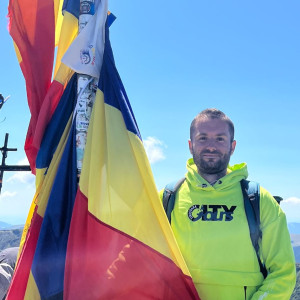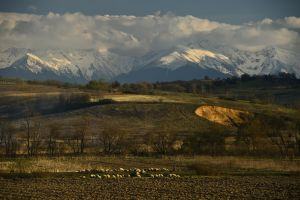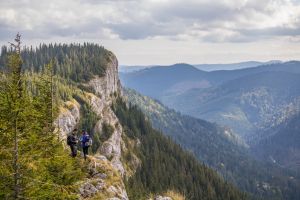
Hiking & Trekking Trips
Romania is a fantastic yet undiscovered and wild destination for hiking and trekking tours! With the Carpathian Mountains dividing the country and occupying almost 55% of the land area, there is so much to explore, natural wonders to admire and peaks to summit! The most popular mountain ranges for hiking trips are Fagaras, Bucegi, Piatra Craiului and Apuseni accessible on 1-day trips from major tourist cities. Check our hiking in Romania guide we prepared with lots of info and suggestions on where to go and how to prepare for your trip.
As Romania's hiking infrastructure is underdeveloped, there are few tourists, lots of bears roaming in the mountains and few people who speak English in the countryside - we highly recommend you go on guided hiking tours with licensed mountain guides who have on-the-ground knowledge of mountain trails and can keep you safe. They will take you on hiking day trips or trekking trips suitable to your physical condition and interests. Check our tours below:
Tour type:

3-day Hiking & Wildlife Trip in the Wild Carpathians
Start from: Rucar village, Arges county
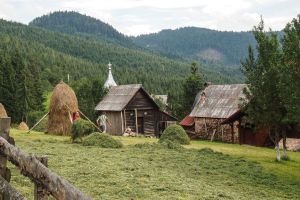
2 Day Hiking in Apuseni Natural Park: Culture & Local Life
Start from: Cluj-Napoca or Sibiu

Picturesque Hiking Trip: Apuseni Natural Park, Rural Life & Scenic Picnic
Start from: Cluj-Napoca

Day Trip to Traditional Mountain Villages: Magura & Pestera
Start from: Brasov

Picturesque Hiking Day Trip in 'Hay-Hut Country'
Start from: Sibiu
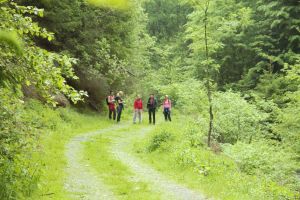
Hiking & Wildlife Tracking Trip in the Carpathians
Start from: Rucar, Leresti, or Nucsoara (Arges county)

2025 Hut-to-Hut Hiking Trip [7 Days, Shared]
Start from: Brasov

Hiking Tour from Timisoara to Remote Villages & Cernei Valley Natural Park
Start from: Timisoara

6-Day Volunteer Trip: Farm Life, Tree Nursery & Wildlife Conservation
Start from: Brasov

{{ activity.title }}
Start from: {{ activity.starting_point }}
Reviews about Hiking & Trekking Trips

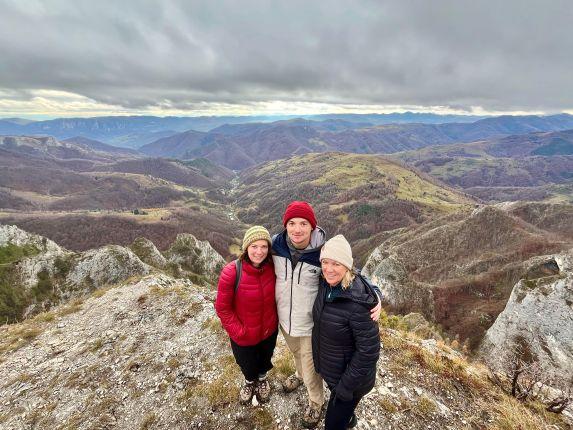
We had a fantastic time on our hike in the Apuseni Mountains. The booking was an easy process, and our guide Radu contacted us right away with more information and details. The day of the hike Radu picked us up in Cluj and drove us to the beautiful countryside. Though people in our group had different fitness levels, we went at a pace that worked for everyone. Radu was a great encourager and a very experienced guide. Highlights include stunning views, a clifftop picnic, and stopping to fill our water bottles at fresh cold mountain springs.


We did the 1 day hike through Piatra Craiului and into the traditional mountain village. This was an amazing experience, especially with the fall colours on the mountains. Our guide, Mihai, was kind, welcoming, knowledgeable and passionate about his job! He had lots of information to share during the drive and the hike and we very much enjoyed the day with him. Marius from Romanian Friend was very helpful in coordinating our excursions and giving us recommendations! I would highly recommend booking with this company.

Our guide was amazing! We really enjoyed the day.

We had a great time with Bogdan on the 7-ladders hike. The hike itself was challenging but we were guided really well. Loved the zip line down
Best Hiking and Trekking Tours in Romania [2025]
Come for the views, stay for the hiking trips. In short, Romania is a great destination for a hiking holiday! Why?
The Carpathian Mountains occupy 37.9% of the country, and with foothills included, that’s almost 55% of Romania’s land area. Additionally, there is an unspoiled pocket of nature in the heart of the country, carefully protected from civilization by the majestic Carpathian Mountains. This is where some of the most impressive trails are, so going on at least one hiking tour while visiting Romania will be a treat!
As far as effort is concerned, the highest peak is Moldoveanu at 2.544 m and there are 14 others above 2.500m to conquer. That's why mountaineering is one of the most popular hobbies for Romanians. Most big cities and mountain-side cities and towns have shops that sell special mountain equipment, from the right clothing to hiking equipment.
This can mean two things:
- if you come unprepared for a trip to the mountains, you can still buy what you need locally
- the mountains in Romania must be taken seriously. So much unspoiled nature is incredible to witness, but also demanding when it comes to conquering it, so having the right equipment is important
- hiking infrastructure is underdeveloped, so it's important to be prepared and not go on self-guided tours if it's your first time in our mountains.
Hikers and outdoor enthusiasts will have many hiking trails and trekking trips to choose from, with rewards in the form of spectacular views. The Carpathian Mountains in Romania are divided into 3 major sections:
- Southern Carpathians (from the Danube River to the Brasov area)
- Eastern Carpathians (from Brasov to the Northern border with Ukraine)
- Western Carpathians (in the Western part of Romania)
The best hiking trips will be in the mountains of Fagaras, Bucegi, Piatra Craiului and Retezat (Southern Carpathians), Apuseni and Trascau (Western Carpathians), Calimani and Rodnei (Eastern Carpathians).
While there are trails for all fitness levels, it's highly recommended to explore Romania with a licensed hiking guide. Some trails are family-friendly, but the further you go into the mountains, the fewer chances you'll have of getting help if you get lost. Trail signage can be outdated or hard to decipher, and cell service may be weak. Without maps or English signs, hiking solo can be risky.
Helpful tips for self-guided Romania hiking tours
If you want to try some of the more accessible trails without a guide, keep these tips in mind.
The emergency number in Romania is 112. The Mountain Rescue unit is called SALVAMONT. They have an amazing website full of useful information but in Romanian. Also, they have a dedicated phone number. However, 112 provides better reception, even in remote areas, and the operator will know which unit is closest to send if you need help.
Always carry cash (avoid large bills) and change them at nearby shops or hotels. Remote villages offer fewer services, so stock up on essentials like food, water, and pharmacy items. Some villages lack ATMs or pharmacies.
For safety, use a phone on the national network to receive RO-Alert messages about severe weather or bear sightings (after all, Romania has the largest bear population in Europe). Make sure your location services are on when hiking.
So, there's no other way to put it, while you could pull off some of the more popular trails, packed with tourists who might speak English and would be able to lend you a helping hand, hiking in Romania is best done with someone who has local knowledge, guidance and preparation.
And let's not forget that on the hiking trail, you may encounter dogs belonging to local shepherds, and they can be quite aggressive if their owner is not nearby.
Don't underestimate the Carpathians – their rugged wilderness can quickly pose a danger, with frequent reports of hikers stranded alone. That's why Romanian Friend works only with licensed mountain guides, who carefully design our tours. And don't worry, these hiking and trekking trips are tailored to your own pace.
Here are the most popular mountain ranges for hiking trips in Romania, easily accessible from Romania’s major cities:
1. Fagaras Mountains
Also called Transylvania's Alps, the Fagaras Mountains are located in the heart of Romania and undoubtedly offer our country's most dramatic landscapes. This is probably the most attractive touristic destination for locals and foreign travelers alike. Every weekend, you will see lines of cars going up Transfagarasan Road.
- If you are planning to drive on what Top Gear called the
best road in the world,do not do it on a weekend, or even on days that could extend into a weekend, like a Friday or a Monday. It will be packed.
But mountaineers will also be pleased: here are Romania's highest peaks and most challenging ridges, meaning hikes are more difficult but also more rewarding! Moldoveanu Peak, which at 2,544 is the highest in Romania, and Negoiu, the 3rd highest, await – but a trekking trail to summit them needs to be well prepared. Luckily, we know the right mountain guides for that!
With around 80 trails in the Făgăraș Mountains and most information in Romanian, a certified guide is essential. A guide can assess your fitness, monitor weather and bear activity, choose refuges, and plan a safe, exciting trip.
Făgăraș is home to stunning glacial lakes, including Balea Lake, the most famous, accessible via cable car year-round (weather permitting). You can reach Balea Lake by car only for a few months per year, mostly between July and November, depending on weather conditions. In winter, enjoy off-piste skiing or a warm drink at the Balea Ice Hotel.
Other glacial lakes include Avrig, Podragel, Lacul Doamnei, and Caltun, along with waterfalls like Balea, Valea Moasei, Negoiu, and Serbota. Trails connect these natural wonders, but a guide is crucial not just for reaching peaks over 2,000 meters, but for knowing how long it takes to summit and return before dark.
The hike to Varful Negoiu (2,535 m), for example, is as tough as it is rewarding, taking experienced hikers 7–8 hours. In a group, fitness levels vary, meaning that timeframe is just a guideline. An overnight stay is inevitable, and a guide is essential to plan it. If you visit in late June, you might spot the rare mountain peony.
Făgăraș Mountains offer diverse trails, some short yet demanding (2–3 hours), others long and challenging, or simply long but manageable. The Turnu Rosu – Suru Peak trail, for instance, takes 10 hours and leads to breathtaking glacial cirques.
For a more accessible yet stunning route, the Balea Lake – Balea Waterfall trail (3.5 hours, medium difficulty) is open year-round, snow permitting.
As far as lodgings go, unless you have somewhere to stay in some of the more popular resorts, there are few options along the way. Even so, on weekends, most of these locations will be packed full because Romanians love to travel on weekends. Booking in advance is always wise.
If you need to stay overnight during your hike, a tent is your only option. If you plan on reaching a peak and wish to sleep at the cabin, you must call ahead and make sure they have room and that they are expecting you. Camping in the wild is NOT RECOMMENDED due to wildlife and safety risks. Use designated camping areas instead. A guide can plan your route to avoid any unexpected dangers.
Still, one thing is sure: whether you seek adventure or scenic walking holidays (and let's not forget that you are close to traditional villages with fortified churches), the Carpathians deliver unforgettable experiences.
2. Apuseni Mountains and National Park
Apart from the reasons stated above, one key reason to hire a hiking guide in the Apuseni is the presence of nature reserves. A guide will make sure you stay on the right path, avoiding wildlife encounters and restricted areas.
The Apuseni Mountains, the main massif of Romania’s Western Carpathians, may not impress with height (Bihor Peak tops at 1,849 m), but their natural wonders and the charming Moților Land traditional villages will exceed your expectations. If strenuous hikes aren’t for you, let a guide plan your scenic walking holidays through picturesque villages and forest trails. Enjoy unspoiled country life without venturing too deep into the Western Carpathians, there’s plenty to see and do in the Moților Villages.
That's why the entire area is part of Apuseni Natural Park and is one of the most popular hiking destinations in Transylvania. These lands with picturesque hills and dense woodlands offer more than meets the eyes: over 200 fascinating caves are open for visitors, deep caving and speleological exploration; some remote areas perfect for dark sky observation; karst formations with narrow canyons ideal for mountaineering, rappelling, via ferrata, white water rafting and many others.
Like all trails in the Carpathian mountains, you have options ranging from a few hours to intense 9–10-hour ascents. Some are circuits, taking you up one way and down another, like the Custurilor Circuit (3–3.5 hours) or the Bohodei Waterfall Circuit, a stunning yet extremely challenging route with steep terrain and chain sections. Only those in top shape should attempt it, and never in rainy weather, as slippery rocks pose serious risks.
The Pietroasa–Bohodei Ridge hike must be followed in one direction, starting from Pietroasa village through Aleului Valley, meadows, and the waterfall, and returning via Șerpilor Valley. Reversing the route is forbidden due to dangerous descents, and the trail is closed in winter.
Top sights in Apuseni Natural Park include Scarisoara Glacier & Ice Cave, Rusty Ravine, Scarita-Belioara Reserve, Bears' Cave, and Bride’s Veil Waterfall. Nearby, Turda Gorge offers stunning hikes and via ferrata adventures. The Apuseni Mountains are easily accessible from Cluj-Napoca, Oradea, and Timișoara.
For safety, stick to homologated trails and have your guide register with Mountain Rescue (Salvamont) on difficult routes. If hiking solo, be aware that not all trails are homologated, and information may be limited. Many unmarked trails, often used by locals or experienced hikers seeking solitude, remain off the grid.
These trails may pass through less safe areas, with limited accessibility in some seasons. The Apuseni Mountains remain wild and are home to many animal species, so it’s best to stay on established trails, with plenty of options to choose from.
3. Retezat Mountains and Natural Park
The Retezat Mountains, a hidden gem of the Carpathians in South-Western Romania near Timisoara, nearly made it to The New 7 Wonders of Nature. Part of the Southern Carpathians, this stunning massif in Hunedoara County offers diverse trails to its highest peak, Peleaga (2,509 m), with glacial lakes along the way. The region remains largely untouched, offering breathtaking natural beauty.
As a national reserve, Retezat is home to many wild animals, so it's best to explore with a guide. It’s also one of Romania’s toughest hiking areas, requiring good physical condition, especially for multi-day trekking tours, which need serious planning.
Winter limits your options to just two trails, but in other seasons, trails range from 2 to 10 hours. With few lodging options, camping is often required. If tents aren’t your thing, consider another range.
The area is home to stunning lakes, like Lake Zanoaga, Stanisoara, and Bucura, with the Lake Bucura – Campul lui Neag trail (7–8 hours) accessible year-round. However, the terrain can be tough, especially around lakes, and the Gura Apei to Lake Bucura trail takes 10–11 hours, not to be attempted in bad weather.
We know licensed mountain guides from Timisoara and Bucharest that can take you on a tour, just let us know. The city of Timisoara is the closest starting point but you can also consider hiking in Domoglead - Cernei Valley Natural Park or Nera – Beusnita National Park, which have natural wonders of their own.
4. Bucegi Mountains
The Sphinx and Babele rock formations found in the Bucegi Mountains (entry from Busteni) are well-known symbols of Romania's Carpathian Mountains. Thousands of tourists beat the trails of this mountain range each year to admire these two fascinating rock sculptures crafted by nature and the views of the surrounding area.
Caraiman Cross, a monument dedicated to World War I fallen soldiers towers over a cliff nearby and is also a major attraction as is Omu Peak, the second highest in Romania at 2,505 m.
At the base of this mountain range, there are many resorts (Sinaia, Busteni, Azuga and Predeal) which can be used by mountain lovers as a base to explore the area, whether during summer or for winter sports. And with famous castles nearby, such as Peles, Cantacuziono or Bran Castle, this has to be on your list!
Hiking in Bucegi Mountain is easy to do on day trips from Bucharest or Brasov.
5. Piatra Craiului National Park
Piatra Craiului Mountains, one of Romania’s most picturesque ranges, offers great views visible from Brașov. It’s perfect for hikers of all fitness levels, with trails ranging from easy countryside walks to more demanding routes requiring mountaineering skills.
The white ridge stretches across the horizon, while nearby villages like Măgura, Moeciu, and Șirnea, at 800m, showcase traditional Romanian life, with livestock often crossing your path.
The big Piatra Craiului National Park circuit takes 12–14 hours, starting and ending in Zarnesti, a mountain village with plenty of lodging options. This challenging route passes woods, and reaches La Om Peak (2,238m), but is closed in winter due to the difficult chain section.
A shorter 5–6 hour circuit also starts in Zarnesti and leads to Curmatura Cabin, offering stunning meadows and great views. After a hearty mountain meal at the Cabin, head back, possibly via the beautiful Gradistea Gorge, surrounded by breathtaking scenery.
Inside Piatra Craiului National Park you shouldn't miss Zarnesti Gorges – a narrow canyon that will isolate you from the outside world. And while you're hiking in the mountains, be sure to look for Bran Castle perched on a ridge nearby!
6. Ceahlau Mountains
The Ceahlău Mountains, in Eastern Romania, are among the wildest and most challenging of the Carpathians.
Durău, in Neamț County, is the closest resort offering food, water, and lodging. Unlike more touristy areas like Brașov or Sinaia, this remote village requires proper gear, and a guide is essential since fewer people speak English here.
Though some trails are marked medium, they are often used by pilgrims, including women in sandals and skirts who climb to the Dochia Cabin (1,706m). If these pilgrims pass you, don’t feel discouraged, they have better endurance than most! So, swallow your pride, be humble and get a guide that will show you the wilderness of the Ceahlau Mountains.
If anytime during the climb you will feel like this is it, it's normal. These are really tough trails.
7. Rodnei Mountains
This is another mountain range in the Eastern Carpathians. Its highest peak is Pietrosu with 2,303 meters and the Rodnei Mountains National Park is the second largest in the country. It is home to 15 glacial lakes, 1200 rare plants, 22 species of lizards, 150 species of birds, and 40 species of mammals. There are about 6 protected natural areas.
It is best to travel accompanied by a special guide who can also give you information about what you are seeing. If you take the trip in May, you could see the mountain peony and the Rodnei Mountain rush-candle. An experienced guide can also make sure you travel respecting the recommendations of the authorities.
8. Ciucas Mountains
Ciucas Mountains are less touristy and promoted than their Bucegi counterparts. However, they are just as inviting and offer hiking opportunities for mountaineering enthusiasts as well as for beginners or people travelling with children.
The landscape is very beautiful, and the trails are less populated. This means that having a guide with you is a good idea given the fact that there is a smaller chance of meeting other tourists who might know English to help out.
The tallest peak to conquer is the Ciucas Peak at 1,954 meters. A climb up to this peak from Bratocea Pass takes about 4 hours. Another 4-hour trail taking also to the Ciucas peak starts from Vama Buzaului. Halfway through the trail, the path becomes steeper and steeper, and you need to watch out for the markings as the path becomes less obvious.

 16 REVIEWS
16 REVIEWS

